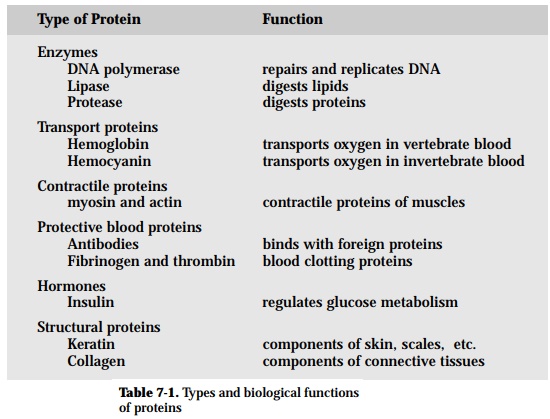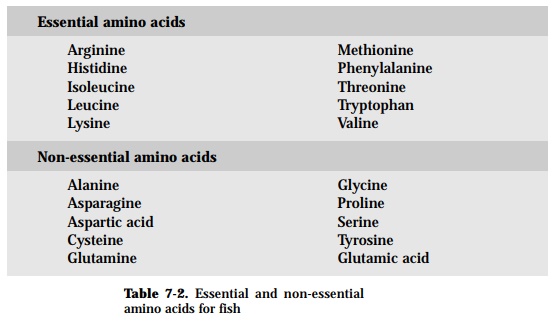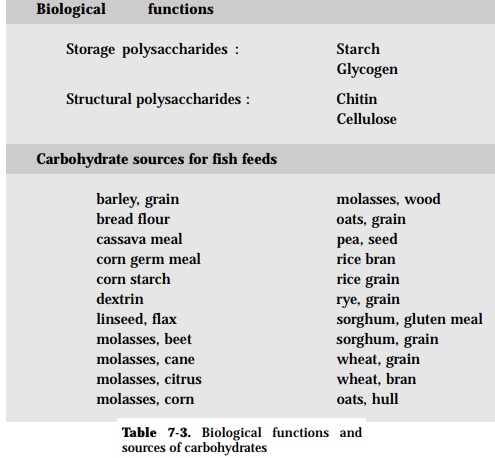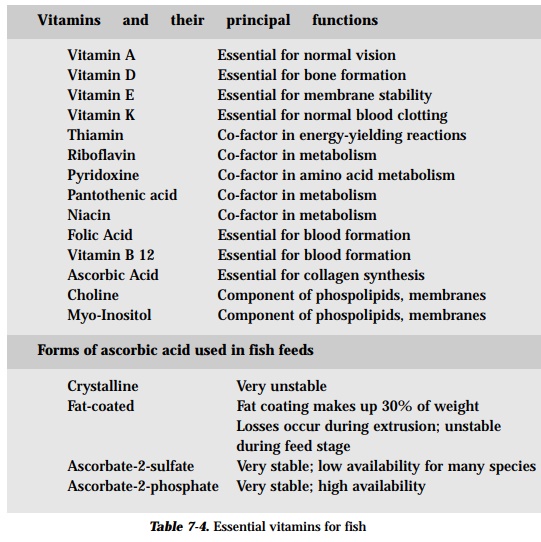Chapter: Health Management in Aquaculture: Nutritional diseases
Components of Feeds - fish in aquaculture
COMPONENTS OF FEEDS
Proteins and amino acids
Table 7-1 shows the types and biologic functions of proteins. The required con-centration of protein in the feed will vary with species, size, age, water temperature, energy levels in the diet, and the quality of protein (digestibility and amino acid content) incorporated in the diet. Fish demand a balanced compo-sition of amino acids in amounts that are adequate to sustain growth. Diets that are insufficient in essential amino acids may give rise to well-defined defi-ciency diseases. Table 7-2 lists the essential and non-essential amino acids. When used as the major protein source, processed fishmeal meets the dietary amino acid requirement. The use of mainly vegetable protein in a diet may make amino acid supplementation necessary. Protein is the most expensive ingredient in fish feed, and it may be tempting to economize on this ingredient. Too little protein will inhibit or retard growth, and may reduce resistance to disease.


Carbohydrates
In crustaceans, carbohydrates either become stored as glycogen or form part of the structural make-up as chitin. Carbohydrates may be used as an energy sup-ply by some species, but only up to a certain level. Most fish species have limited ability to metabolize carbohydrates, and have no nutritional demand for them. Since fish poorly utilizes carbohydrates, it eliminates the nutrient from the body in feces, and cause pollution concerns in fish farm sites. Some sources of carbohydrates for fish feeds are given in Table 7-3.

Fats and lipids
Lipids supply the fish with essential fatty acids that are necessary structuralcomponents of all cell membranes. Lipids are of great importance for physi-ological processes. They are also necessary for absorption of some vitamins, and constitute a relatively cheap energy source. The quality of lipids used in the diet should not be ignored. Polyunsaturated fatty acids are easily oxidized under storage especially under warm temperature. Rancid lipids are known to induce lipoid liver disease in fish.
Vitamins
Vitamins are complex organic substances that are essential to a wide variety of metabolic processes. They are only required in small amounts in the diet, but requirements for vitamins may increase during growth and spawning. Vita-mins are divided into two classes: fat-soluble and water-soluble. Some vita-mins like ascorbic acid are unstable in storage. This is why some feed manufac-turers use more stabilized forms of ascorbic acid in their feed formulations. A listing of essential vitamins for fish as well as the forms of ascorbic acid used in fish feeds are given in Table 7-4.

Minerals
Fish require minerals for maintenance of osmotic balance between body fluids and their environment. Seven major minerals are required in large amounts and constitute 60-80% of all inorganic materials in the body. The seven minerals are calcium, phosphorous, sulfur, sodium, chlorine, potassium, and magnesium. Trace minerals are just as essential as major minerals, but are needed only in small amounts. The nine essential trace minerals are iron, copper, manganese, cobalt, zinc, iodine, molybdenum, fluorine, and selenium.
Pigments
Pigments added to feeds result in an attractive red flesh color in salmonids. Quite large levels of shrimp meal in the diet can achieve good results as well. Feed manufacturers usually include synthetic analogues of the naturally occurring pigment asthaxanthin or cathaxanthin as additives.
Antioxidants, binder, and other feed components
Fish feeds contain high levels of unsaturated oils that easily oxidize resulting in breakdown of oils and other nutrients. This can be controlled by adding antioxidants such as butylhydroxytoluene (BHT), butylhydroxyanisole (BHA), ethoxyquin, and tocopherol (vitamin E). The levels of BHT, BHA, and ethoxyquin allowed in feeds by regulations often are not adequate to control oxidation of the high levels of unsaturated oils in fish feeds. When additional antioxidants are needed, feed formulators should supplement with vitamin E to the levels permitted to protect the oils in fish feeds.
Fiber is an indigestible dietary material derived from cell walls. In concentra-tions of less than 8% fiber may add structural integrity to pellet feeds. Larger amounts often impair pellet quality. Carbohydrates are important binders in commercial fish feed production. Taste or palatability of the ration for each of the fish species must also be considered. Complete feed rations include attrac-tants to draw fish attention to the feed.
Related Topics